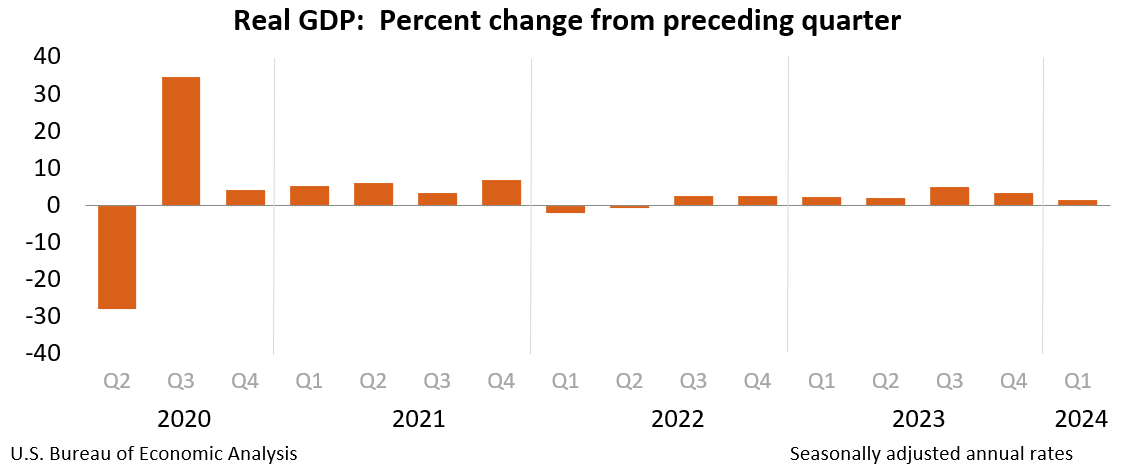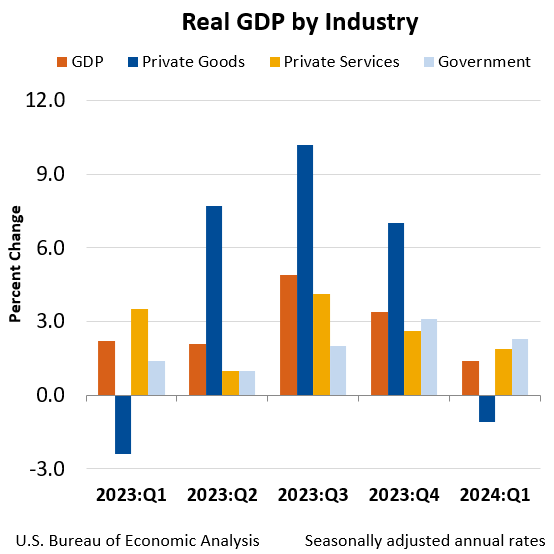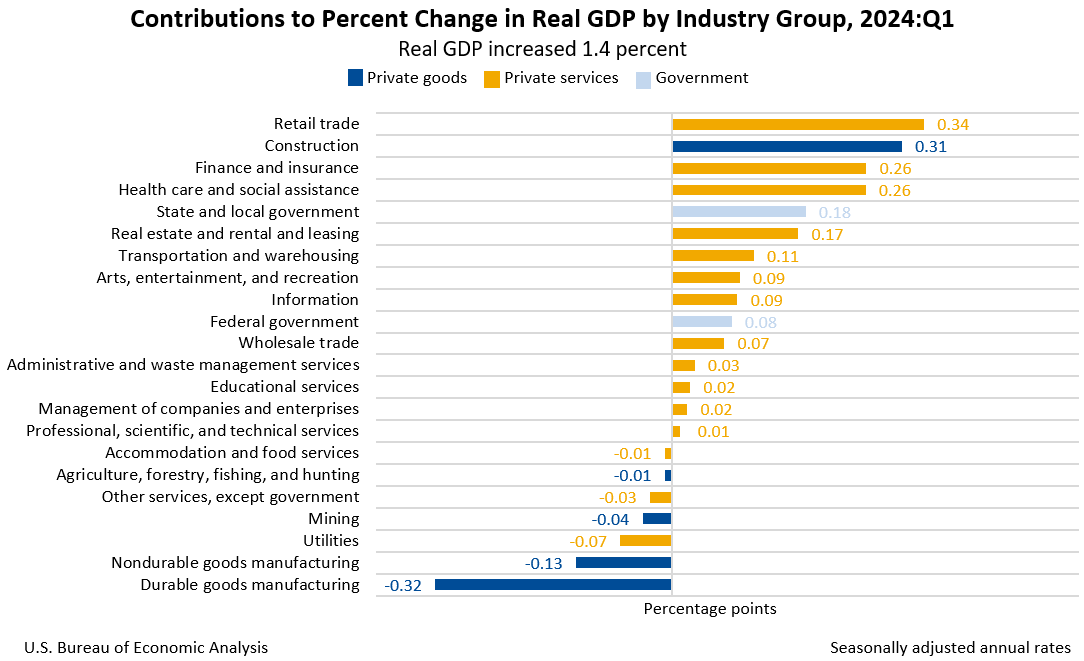Real gross domestic product (GDP) grew at an annual rate of 1.4% in the first quarter of 2024 (Table 1), according to the “third” estimate released by the Bureau of Economic Analysis. In the fourth quarter of 2023, real GDP increased by 3.4 percent.
The GDP estimate released today is based on more comprehensive source data than was available for the “second” estimate released last month. In the second estimate, the increase in real GDP was 1.3 percent. The upward revision mainly reflects a downward revision of imports, which constitute a subtraction in the calculation of GDP, and upward revisions of non-residential fixed investment and public spending. These revisions were partly offset by a downward revision in consumer spending (see “GDP Updates”).

The increase of Real GDP primarily reflects increases in consumer spending, residential fixed investment, nonresidential fixed investment, and state and local government spending, which were partly offset by decreases in private inventory investment. Imports increased (Table 2).
Compared to the fourth quarter, the deceleration Real GDP mostly reflects a deceleration in consumer spending, exports, and state and local government spending, as well as a slowdown in federal government spending. These movements were partly offset by an acceleration in residential fixed investment. Imports have accelerated.
GDP in current dollars grew 4.5 percent year-on-year, or $312.2 billion, in the first quarter to reach a level of $28.27 billion, an upward revision of $13.2 billion from to the previous estimate (tables 1 and 3). Further information on the source data underlying the estimates is available in the “Key source data and assumptions” file on the BEA website.
THE gross domestic purchases price index increased by 3.1 percent in the first quarter, an upward revision of 0.1 percentage point from the previous estimate (Table 4). Personal consumption expenditure (PCE) price index increased by 3.4 percent, an upward revision of 0.1 percentage point. Excluding food and energy prices, the PCE price index rose 3.7 percent, an upward revision of 0.1 percentage point.
Personal income
Personal income in current dollars increased by $396.8 billion in the first quarter, a downward revision of $7.7 billion from the previous estimate. This increase mainly reflects increases in compensation (led by private sector wages and salaries) and personal current transfer receipts (led by public social benefits provided to individuals) (Table 8).
Disposable personal income rose $240.2 billion, or 4.8 percent, in the first quarter, a downward revision of $26.6 billion from the previous estimate. Real disposable personal income increased by 1.3 percent, a downward revision of 0.6 percentage points.
Personal savings was $777.3 billion in the first quarter, a downward revision of $19.3 billion from the previous estimate. THE personal savings ratePersonal savings as a percentage of personal disposable income was 3.8 percent in the first quarter, the same as the previous estimate.
Gross domestic income and corporate profits
Real gross domestic income (RNB) rose 1.3 percent in the first quarter, a downward revision of 0.2 percentage points from the previous estimate. THE average of real GDP and real RIBa supplemental measure of U.S. economic activity that weights GDP and GNI equally, increased 1.4% in the first quarter, similar to the previous estimate (Table 1).
Benefits of current production (corporate profits with adjustments for inventory valuation and capital consumption) decreased by $47.1 billion in the first quarter, a downward revision of $26.0 billion from the estimate previous (table 10).
Profits of domestic financial companies increased by $65.0 billion in the first quarter, a downward revision of $8.7 billion from the previous estimate. Profits of domestic non-financial corporations decreased by $114.5 billion, a downward revision of $0.3 billion. Profits from the rest of the world increased by $2.3 billion, a downward revision of $17.0 billion. In the first quarter, receipts increased by $25.7 billion and payments by $23.4 billion.
GDP Updates
With the third estimate, a downward revision to imports and upward revisions to nonresidential fixed investment, state and local government spending, exports, federal government spending, private inventory investment, and investment residential fixed income were partly offset by a downward revision in consumer spending. For more information, see the technical note. For more information on GDP updates, see the “Additional Information” section that follows.
| Advance estimate | Second estimate | Third estimate | |
|---|---|---|---|
| (Percentage change from previous quarter) | |||
| Real GDP | 1.6 | 1.3 | 1.4 |
| GDP in current dollars | 4.8 | 4.3 | 4.5 |
| Real RDB | … | 1.5 | 1.3 |
| Average of real GDP and real GNI | … | 1.4 | 1.4 |
| Gross domestic purchases price index | 3.1 | 3.0 | 3.1 |
| PCE Price Index | 3.4 | 3.3 | 3.4 |
| PCE price index excluding food and energy | 3.7 | 3.6 | 3.7 |
Real GDP by industry
Today’s release includes estimates of GDP by industry, or value added – a measure of an industry’s contribution to GDP. Private goods-producing industries declined by 1.1 percent, private services-producing industries grew by 1.9 percent, and government grew by 2.3 percent (Table 12). Overall, 15 of 22 industry groups contributed to the increase in real GDP in the first quarter.
- In the private goods-producing sectors, the main factors driving this decline were the manufacturing of durable goods (mainly primary metals) and the manufacturing of non-durable goods (mainly petroleum and coal products). These declines were partly offset by an increase in construction (table 13).
- Within private service industries, the largest contributors to the increase are retail trade (led by automobile and parts dealers), finance and insurance (led by the Federal Reserve Banks, the credit intermediation and related activities), as well as health care and social assistance. (led by Ambulatory Health Services).
- The government increase reflects increases in state and local as well as federal government.


Gross production by industry
Actual gross production— primarily a measure of an industry’s sales or revenues, which includes sales to end users in the economy (GDP) and sales to other industries (intermediate inputs) — increased 2.5 percent in the first quarter. Private goods-producing industries increased 1.2 percent, private services-producing industries increased 3.1 percent, and the public sector increased 1.7 percent (Table 16). Overall, 14 of the 22 industry groups contributed to the increase in real gross output.
* * *
Next release, July 25, 2024, 8:30 a.m. EDT
Gross domestic product, second quarter 2024 (preliminary estimate)
* * *